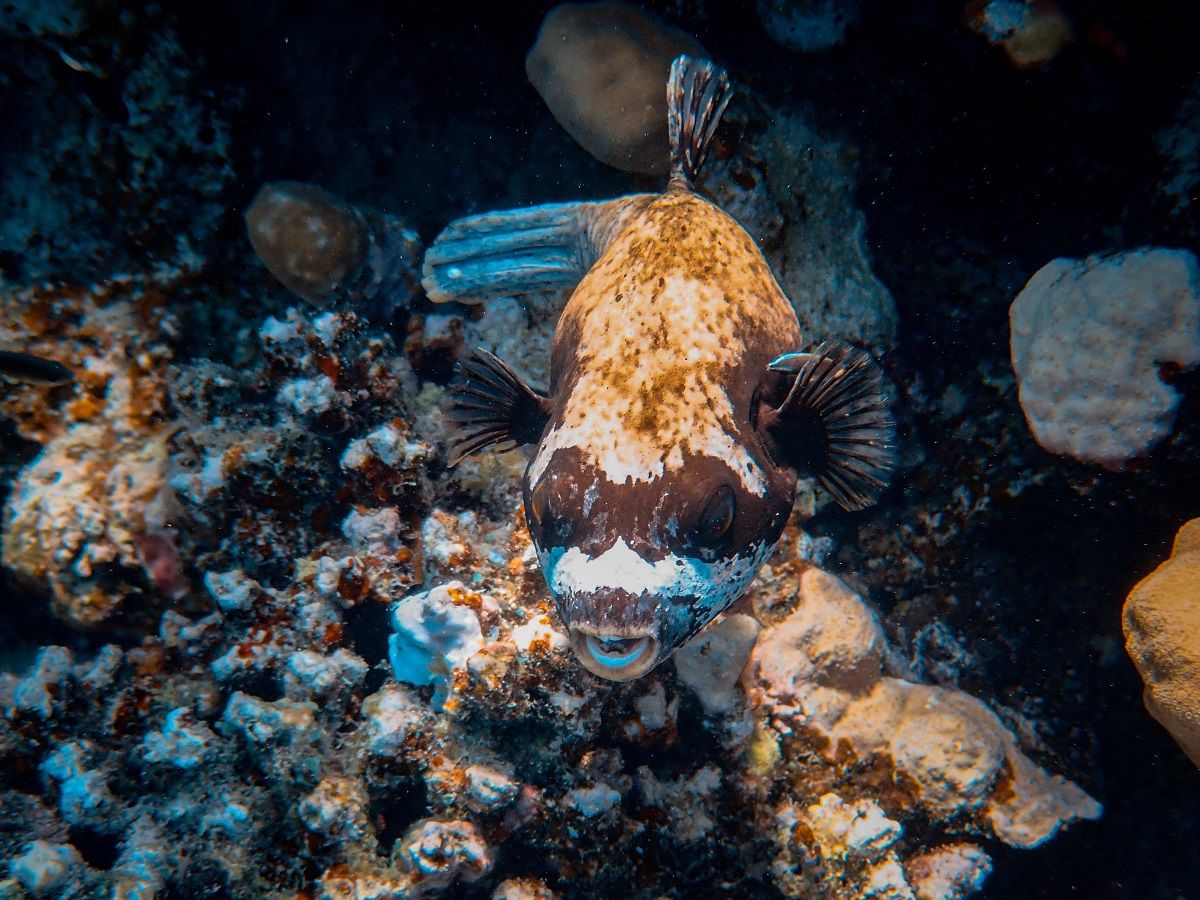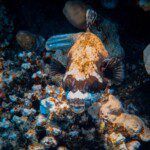Looking for an unusual addition to your saltwater aquarium? You might just have found it! The dogfaced pufferfish (Arothron nigropunctatus) is a pretty funky-looking species. It can make a great choice for the somewhat experienced aquarist who is looking for an underwater pet they can really connect with.
Keep reading for everything you need to know about dogfaced pufferfish and keeping one in your home aquarium!
| Name (Common, Scientific) | Dogfaced pufferfish, dog-face pufferfish, blackspotted puffer, Arothron nigropunctatus |
| Minimum tank size | 100 gallons |
| Minimum group size | 1 |
| Temperature | 74-78 °F |
| Salinity | 1.020-1.025 |
| pH | 8.1-8.4 |
| Difficulty level | Intermediate |
Dogfaced pufferfish description
Given its pointy, snout-like face, we probably don’t have to explain where the dogfaced pufferfish got its common name. This species is a typical puffer: it sports an oval body shape with big teeth and no scales. It’s also referred to as the blackspotted puffer (that’s what its scientific name, nigropunctatus, means).
Dogfaced pufferfish are generally greyish to brownish in color, with a white stripe across the nose, darker coloration in the face, and scattered black spots over the entire body.
Interestingly, there are also dogfaced puffers with yellow bellies or even a bright yellow body. This yellow form is quite difficult to tell apart from the yellow morph of the dogface’s similar-looking cousin, Arothron meleagris.
This is not a small fish. Dog-faced puffers can grow to over a foot in length (around 13″). Still, that’s not very big compared to some of its cousins, like the 18″ stars and stripes puffer.
Did you know? Like other puffer species, the dogfaced pufferfish can indeed puff up its body when it feels threatened. Don’t try to provoke your fish into puffing, as it greatly stresses them out. Also avoid ever exposing this species to air, as they can ingest air while trying to puff and might not survive the ordeal.
Dogfaced pufferfish natural habitat
The dogfaced pufferfish has a pretty sizeable natural range. It’s found in the wild in the Indo-Pacific, from East Africa all the way to the islands in the central Pacific. Here, the species can be found at a depth of up to 82ft.
In its natural habitat, the blackspotted puffer is a reef fish. It’s considered to be a species of Least Concern by the IUCN Red List, although the organization does note that all reef species worldwide are under pressure as a result of human activity.
Wild dogfaced puffers live either solitarily or in pairs. They’ve been noted to use the services of cleaner shrimp to keep themselves free of parasites. They can interbreed with some fellow members of their genus, like A. meleagris and A. mappa.
Did you know? Like all puffers, dogfaces are highly toxic (though they can’t harm you unless you try to eat them). They contain a highly potent neurotoxin called tetrodotoxin, as well as some other lethal substances.
Yotsu-Yamashita, Nagaoka, Muramoto, Cho, & Konoki (2018)
Dogfaced pufferfish aquarium & tankmates
Aquarium
As mentioned above, the dogfaced pufferfish can reach a size of over a foot. That means a small aquarium is not going to cut it if you’re interested in keeping one. A tank of 100 gallons or more in volume is a good start, although bigger is better.
Standard reef parameters work fine for a blackspotted puffer. Make sure to keep the water quality high, as this species doesn’t respond well at all to fluctuations in ammonia, nitrite and nitrate levels. An extra-strong filter and protein skimmer can be handy, as they are messy eaters.
The layout of the aquarium doesn’t matter much as long as there’s plenty of space available. You can include plenty of live rock.
Compatibility
It’s important to remember that dogfaced pufferfish are considered to be at least semi-aggressive. They are predators and grow pretty large, so they can pose a threat to some types of tankmates.
Puffers like this one are particularly focused on invertebrates, which make up their natural diet. If you keep shrimp, crabs, clams and other inverts in your tank, you might want to think twice about adding a pufferfish to the mix. Other fish will generally be left alone, but still, it’s best to avoid anything that fits into the puffer’s mouth.
Good tankmates include similarly large species, though preferably nothing overly aggressive. Peaceful or semi-aggressive fish like triggerfish, angelfish and some eels should do alright, although many aquarists opt to just keep their puffer alone.
As for coral compatibility, don’t even think about it. Blackspotted puffers in the wild feed on a range of corals, with researchers noting that Acropora and Pocillopora corals are their favorites. Not reef-safe at all.
Did you know? These puffers don’t really play nice with their own kind except if they’re a mated pair in a very large tank. It’s best to keep yours on its own.
Dogfaced pufferfish diet
Their diet is the main reason why pufferfish are generally considered difficult to keep in the aquarium. As we discussed, their natural diet consists of invertebrates: clams and other mollusks, crustaceans, and even sea sponges. That’s why they have those powerful teeth, which come in handy for cracking even the toughest shells.
In the aquarium, you won’t get away with offering your dogfaced pufferfish flakes or pellets. They need a diet similar to what they eat in the wild. Not only will they likely refuse commercial foods, but they can even cause issues.
Basically, puffers have evolved to sport ever-growing teeth, a bit like rabbits. After all, their chompers are naturally worn down by the hard foods they consume. If you feed soft foods in the aquarium, your blackspotted puffer might end up with horribly overgrown teeth and become unable to feed properly.
It’s possible to give a puffer a tooth trim, yes, but it’s always better to try and avoid the issue altogether. The fish has to be sedated in order to trim its teeth, so the whole thing can be quite stressful and even dangerous.
The ideal food would be live, like crabs, clams, and shrimp. As that would quickly get expensive, however, most aquarists choose to go for frozen foods.
Did you know? Normally, this is where the section on breeding a fish would go. Bad luck, though: we haven’t heard about anyone managing to breed them in captivity. There isn’t even really anything known about their reproductive characteristics as far as we’re aware, so scientists have their work cut out for them.
Conclusion
The dogfaced pufferfish is a fun fish to keep, with interesting looks and fascinating behavior. Some aquarists feel they can really bond with this intelligent species—like a real underwater dog! However, it does need a specialized diet and an XL aquarium to thrive.
Thinking about your own saltwater aquarium (with or without puffer)? FantaSEA Aquariums can design, set up and maintain your tank for you. Just contact us!
Sources & further reading
Bonaldo, R. M., Grutter, A. S., Sazima, I., & Krajewski, J. P. (2015). 24/7 service: nocturnal cleaning in a tropical Indo-Pacific reef. Marine Biodiversity, 45, 611-612.
Bourjon, P., & Chanet, B. (2017). Two cases of probable hybridisation between the pufferfishes Arothron meleagris (Anonymous 1798) and A. nigropunctatus (Bloch and Schneider 1801) on a fringing reef at Réunion Island. African journal of marine science, 39(4), 503-507.
Hobbs, J. P. A., Frisch, A. J., Allen, G. R., & Van Herwerden, L. (2009). Marine hybrid hotspot at Indo-Pacific biogeographic border. Biology letters, 5(2), 258-261.
Yotsu-Yamashita, M., Nagaoka, Y., Muramoto, K., Cho, Y., & Konoki, K. (2018). Pufferfish saxitoxin and tetrodotoxin binding protein (PSTBP) analogues in the blood plasma of the pufferfish Arothron nigropunctatus, A. hispidus, A. manilensis, and Chelonodon patoca. Marine Drugs, 16(7), 224.






